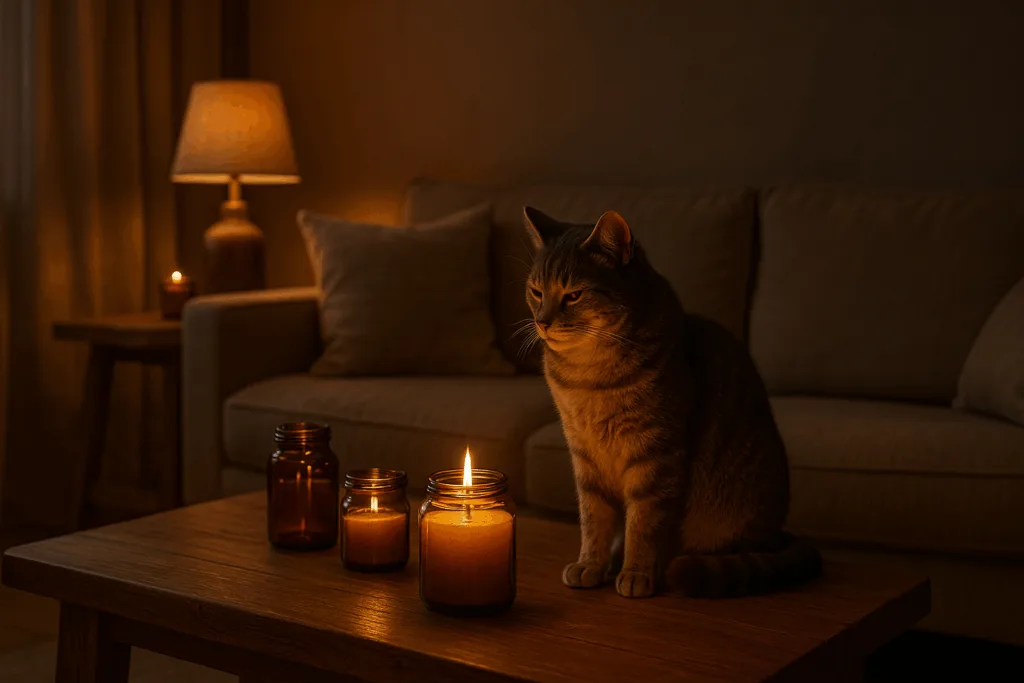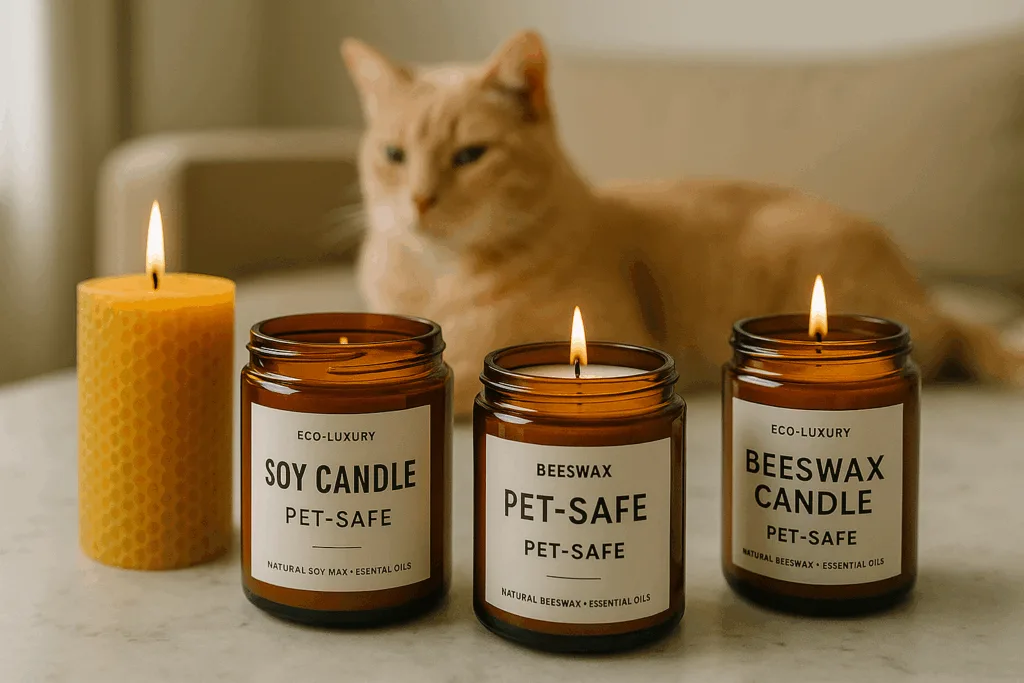
Introduction: Why Candle Safety Matters for Cat Owners
The comforting glow of a candle has long symbolized tranquility—a gentle flicker that transforms any room into a warm sanctuary. But for cat owners, lighting a candle is more than a simple act of ambiance; it’s a matter of safety and awareness. Cats possess delicate respiratory systems and an innate curiosity that can turn a small flame into a potential hazard. As the popularity of home fragrance continues to rise, understanding what candles are safe for cats becomes an essential part of responsible pet ownership.
Unlike humans, cats process airborne chemicals differently. They lack key liver enzymes required to metabolize many compounds found in fragrances and waxes. This means that what smells like a soothing lavender or citrus note to you may represent a toxic irritant to your feline friend. Beyond scent, the type of wax, wick, and additives all play critical roles in determining a candle’s safety profile.
At Circe Home, where luxury meets consciousness, the conversation around pet-safe candles is central to our design ethos. This guide dives deep into the science, materials, and mindful craftsmanship behind non-toxic candle options for cats in 2025.
The Rise of Home Fragrance and Pet Safety Awareness
In 2025, the global candle market continues to flourish—with an estimated value surpassing $13 billion. Consumers are drawn to candles not only for scent and decor but for emotional wellness: to unwind, reconnect, and create sensory-rich living spaces. Yet, a parallel movement has emerged among conscientious homeowners: the pursuit of clean, pet-safe candles that align with sustainability and wellbeing.
Social media and veterinary awareness campaigns have elevated public understanding of household toxins affecting pets. Studies indicate that paraffin-based candles emit volatile organic compounds (VOCs) such as toluene and benzene, which can trigger respiratory distress in sensitive animals. This has spurred innovation toward plant-based, biodegradable alternatives.
Pet-friendly living no longer means sacrificing aesthetics. In fact, brands like Circe Home are proving that elegant design and animal safety can coexist through careful ingredient selection, eco-certifications, and cruelty-free practices.
Understanding Feline Sensitivities
Cats are biologically unique. Their livers lack specific enzymes involved in glucuronidation—a process that allows the body to break down toxins. As a result, compounds that are harmless to humans and dogs can linger in feline systems, leading to potential toxicity over time.
Common symptoms of fragrance sensitivity in cats:
- Sneezing or coughing when candles are lit
- Watery eyes or nasal discharge
- Lethargy or unusual hiding behavior
- Vomiting or drooling after exposure
A seemingly mild exposure, repeated over months, can contribute to chronic issues like asthma or liver strain. This underscores the importance of choosing non-toxic candles for cats crafted from natural, low-emission ingredients.
The Science Behind Candle Emissions
When a candle burns, it releases more than just fragrance. The combustion of wax and wick emits ultrafine particles, soot, and trace chemicals. In enclosed environments, these emissions can accumulate, impacting both human and animal airways.
- Soot: Fine black carbon particles that may irritate mucous membranes.
- VOCs: Volatile organic compounds responsible for synthetic fragrance diffusion.
- PAHs: Polycyclic aromatic hydrocarbons that can emerge from incomplete combustion.
In 2025, advanced manufacturing techniques allow for cleaner-burning waxes with minimal soot and reduced VOCs. Circe Home’s wax blends, for example, undergo third-party emission testing to ensure each candle meets European indoor air quality standards.
Common Candle Materials and Their Effects on Pets
| Candle Material | Safety for Cats | Description |
|---|---|---|
| Paraffin Wax | ❌ Unsafe | Derived from petroleum; emits soot and VOCs when burned. |
| Soy Wax | ✅ Safer | Plant-based and biodegradable; burns cleanly with minimal smoke. |
| Beeswax | ✅ Safest | 100% natural; purifies air by releasing negative ions. |
| Coconut Wax | ✅ Excellent | Renewable, low soot, and slow-burning. |
| Gel Wax | ❌ Unsafe | Contains mineral oils and synthetic additives. |
Understanding each wax type empowers consumers to make choices that protect both air quality and feline wellbeing.
Paraffin Wax: The Hidden Danger in Conventional Candles
Paraffin wax, a byproduct of petroleum refining, remains the most common candle material in mass production due to its low cost and high fragrance retention. However, burning paraffin releases benzene and toluene—known carcinogens—as well as microscopic soot particles that can cling to fur, furniture, and lungs.
For cats, even low exposure can exacerbate asthma or cause coughing and sneezing. Since cats groom themselves frequently, soot particles on fur may also be ingested, leading to digestive upset.
In 2025, conscious brands are abandoning paraffin altogether, choosing soy, beeswax, or coconut wax as superior, safe alternatives.
Soy Wax Candles: A Cleaner, Safer Alternative
Soy wax, derived from hydrogenated soybean oil, has become the gold standard for eco-conscious candle manufacturing. It burns longer, cooler, and with significantly less soot than paraffin.
Benefits for Cat Owners:
- Non-toxic and renewable
- Produces minimal smoke and residue
- Vegan and cruelty-free
- Compatible with low-fragrance blends
Circe Home’s soy-based formulations are carefully curated to ensure slow, even melting—reducing hot spots that might otherwise emit micro-particles. When paired with wooden or cotton wicks, soy wax creates a serene, soft crackle without compromising air purity.
Beeswax Candles: Natural Purity and Pet Safety
For centuries, beeswax has symbolized natural purity. It burns with a warm golden hue and a faint, honeyed aroma that needs no synthetic enhancement. Beeswax candles naturally purify air by releasing negative ions that bind to dust and pollutants, effectively cleansing indoor environments.
For cat owners, this makes beeswax an ideal choice—non-toxic, minimally processed, and hypoallergenic. Circe Home sources ethically harvested beeswax from cruelty-free apiaries, ensuring both ecological and animal welfare standards are met.
Note: Always confirm that beeswax candles are 100% pure; blends with paraffin can compromise safety.
Coconut Wax: The Eco-Luxury Option for Pet-Friendly Homes
Coconut wax, a relative newcomer to the candle scene, is quickly becoming the hallmark of sustainable luxury. Made from cold-pressed coconut oil, it boasts superior scent throw and a clean, long-lasting burn. Its smoke output is virtually negligible, making it exceptionally gentle for sensitive pets.
Circe Home’s coconut wax line combines eco-luxury with feline safety. Every batch is free from paraffin, synthetic dyes, and phthalates—allowing fragrance expression that feels natural, never overwhelming.
Fragrance Oils vs. Essential Oils: What Cat Parents Should Know
The choice between fragrance oils and essential oils is crucial when selecting candles safe for cats. While essential oils are natural, many can still be toxic to felines. Conversely, some synthetic fragrance oils, when formulated responsibly, may pose fewer risks.
Best Practice: Choose candles with either no fragrance or those explicitly labeled as “pet-safe” with low-toxicity, non-volatile blends.
Toxic Essential Oils for Cats: What to Avoid
Avoid candles containing any of the following oils:
- Tea Tree (Melaleuca)
- Eucalyptus
- Citrus (Lemon, Orange, Grapefruit)
- Peppermint
- Pine or Cedar
- Wintergreen
Even minimal exposure can irritate or intoxicate cats. Safer fragrance families include chamomile, vanilla, and pure beeswax aroma.
Safe Scent Families and Gentle Fragrance Blends
If you prefer scented candles, select gentle, naturally derived notes that don’t overwhelm your cat’s heightened olfactory sense:
| Safe Fragrance Notes | Characteristics |
| Chamomile | Calming, herbal, subtle |
| Vanilla | Warm, sweet, familiar |
| Rose | Mildly floral, comforting |
| Honey | Natural, soft, sweet aroma |
Circe Home’s 2025 Pet-Safe Collection focuses on these low-intensity fragrance families to maintain ambiance while preserving animal wellness.
The Role of Wicks: Why Metal-Free Matters
Older candle designs sometimes incorporated metal-core wicks for rigidity, but traces of lead or zinc could contaminate indoor air. Today, high-quality candles use 100% cotton, hemp, or FSC-certified wooden wicks for a toxin-free experience.
Circe Home’s wicks are hand-braided cotton dipped in vegetable-based wax, ensuring smooth combustion and a gentle flame ideal for small spaces shared with pets.
Candle Design: How Vessel Choice Affects Safety
Beyond ingredients, container design plays an unsung role in pet safety. Wide, low vessels may tempt curious paws, while deep glass jars or ceramic holders add protective depth. Always ensure stability to prevent tipping and potential wax spills.
The Importance of Ventilation in Pet Homes
Good airflow is essential when burning any candle—even the safest one. Ventilation disperses vapors, maintains oxygen levels, and minimizes buildup of airborne particulates.
Tips:
- Open windows or doors when burning candles.
- Avoid lighting multiple candles in small rooms.
- Extinguish candles before sleeping or leaving pets unattended.
Circe Home’s Commitment to Non-Toxic Candle Crafting
At Circe Home, we view candle creation as an art form guided by responsibility. Each ingredient—from wax to wick—is ethically sourced and tested for purity. Our production process follows strict quality control protocols:
- 100% paraffin-free formulation
- VOC emissions below EU indoor air thresholds
- Use of IFRA-certified fragrance oils only
- Biodegradable packaging and recyclable glass jars
Our aim is simple: to allow you to enjoy atmospheric light and fragrance without compromising your cat’s wellbeing.
How Circe Home Tests Candle Safety for Pets
We partner with independent laboratories to assess particulate emissions and volatile compound profiles under real burn conditions. Additionally, each fragrance undergoes toxicological screening to ensure no harmful essential oil compounds are present.
Sustainable Manufacturing: Beyond Pet Safety
True sustainability extends beyond toxicity. Circe Home’s operations integrate renewable energy, plastic-free packaging, and cruelty-free testing. By combining eco-luxury and ethical craftsmanship, we ensure that our candles honor both your home environment and the natural world that inspires them.
Best Practices for Burning Candles Around Cats
- Always supervise burning candles.
- Keep flames far from whisker height.
- Burn for limited durations (2–3 hours).
- Store candles out of reach when cooled.
- Observe your cat for signs of irritation.
Cat-Friendly Candle Alternatives: Diffusers and LED Options
For pet parents seeking ultimate peace of mind, flameless candles and LED diffusers provide safe ambiance without combustion. Rechargeable LED candles mimic real flame movement using flicker technology—perfect for evening tranquility with zero risk.
Non-Toxic Candle Brands to Explore in 2025
- Circe Home Pet-Safe Collection
- Pet House Candles
- P.F. Candle Co. Soy Line
- Project Sudz Odor Control Candles
- Fontana Candle Co. Beeswax Blends
These brands prioritize transparency, ethical sourcing, and clean-burning materials.
DIY Cat-Safe Candle Recipes
Create your own cat-safe candles using simple, non-toxic ingredients:
Ingredients:
- 1 cup pure soy or beeswax
- 1 cotton wick
- 1 tsp vanilla extract (optional)
Steps:
- Melt wax gently over a double boiler.
- Pour into a glass jar with wick centered.
- Let cool for 24 hours before lighting.
How to Store Candles Safely in Pet Homes
- Keep candles in sealed containers when not in use.
- Avoid scented storage near cat food or litter areas.
- Maintain cool, dry conditions to preserve wax integrity.
Conclusion: Creating a Serene and Safe Atmosphere for All
Your home should feel like a sanctuary—for both you and your pets. Choosing non-toxic candles safe for cats ensures that beauty and safety coexist harmoniously. As 2025 ushers in greater environmental and ethical awareness, Circe Home stands committed to leading this transformation through craftsmanship that respects nature, enhances mood, and protects every life it touches.
FAQ: Cat-Safe Candles and Pet Wellness
Are soy candles safe for cats?
Yes, pure soy candles are among the safest options when unscented or lightly fragranced with pet-safe ingredients.
Can I burn candles if my cat has asthma?
It’s best to avoid open-flame candles. Choose flameless LED alternatives to eliminate any respiratory irritants.
Are beeswax candles safe for cats?
Absolutely—pure beeswax candles burn cleanly and even help neutralize indoor pollutants.
Which scents should I avoid around cats?
Avoid strong essential oils like eucalyptus, tea tree, citrus, peppermint, and pine.
What are the safest candle brands for pet owners in 2025?
Circe Home, Pet House Candle, and Fontana Candle Co. offer verified non-toxic, pet-safe formulations.
Can I make my own cat-safe candles at home?
Yes—use soy or beeswax, cotton wicks, and minimal or no fragrance.




